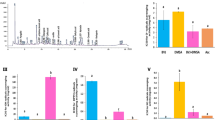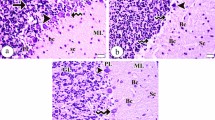Abstract
DURING the past few years, three neurotoxic principles that are amino-acid in nature, 2,4-diaminobutyric acid1, β-N-oxalyl-2,3-diaminopropionic acid2, and β-cyanoalanine in both free and peptide forms3,4 have been isolated from seeds of Lathyrus and vetch plants. This is of interest because lathyrism, a neurological disease in man and certain animals, has at times been associated with excessive consumption of certain peas containing these compounds5. Little is known about the biological basis of neurolathyrism or of the toxicity of the isolated principles. We wish to report here evidence that seems to indicate a link between the action of β-cyanoalanine and vitamin B6.
This is a preview of subscription content, access via your institution
Access options
Subscribe to this journal
Receive 51 print issues and online access
$199.00 per year
only $3.90 per issue
Buy this article
- Purchase on Springer Link
- Instant access to full article PDF
Prices may be subject to local taxes which are calculated during checkout
Similar content being viewed by others
References
Ressler, C., Redstone, P. A., and Erenberg, R. H., Science, 134, 1 (1961).
(a) Roy, D. N., Nagarajan, V., and Gopalan, C., Current Sci., 32, 116 (1963); (b) Rao, S. L. N., Adiga, P. A., and Sarma, P. S., Biochem., 3, 432 (1964); (c) Murti, V. V. S., Seshadri, T. R., and Venkitasubramanian, T. A., Phytochem., 3, 73 (1964).
Ressler, C., J. Biol. Chem., 237, 733 (1962).
Ressler, C., Nigam, S. N., Giza, Y.-h., and Nelson, J., J. Amer. Chem. Soc., 85, 3311 (1963).
For a review, see Ressler, C., Fed. Proc., 23 (in the press).
Feinstein, M. B., Curtis, D. T., and Ressler, C., Fed. Proc., 21, 650 (1962).
Ressler, C., and Ratzkin, H., J. Org. Chem., 26, 3356 (1961).
Spackman, D. H., Stein, W. H., and Moore, S., Anal. Chem., 30, 1190 (1958).
Frimpter, G. W., Haymovitz, A., and Horwith, M., New Eng. J. Med., 268, 333 (1963).
Winegard, H. M., Toennies, G., and Block, R. J., 108, 506 (1948).
Nigam, S. N., and Ressler, C., Biochim. Biophys. Acta (in the press).
(a) Chatagner, F., Tabechian, H., and Bergeret, B., Biochim. Biophys. Acta, 13. 313 (1954); (b) Blaschko, H., and Hope, D. B., Biochem. J., 63, 7P (1956); (c) Hope, D. B., Biochem. J., 66, 486 (1957).
du Vigneaud, V., A Trail of Research in Sulfur Chemistry and Metabolism and Related Fields, 27 (Cornell University Press, Ithaca, N.Y., 1952).
Binkley, F., Christensen, G. M., and Jensen, W. N., J. Biol. Chem., 194, 109 (1952).
Harris, H., Penrose, L. S., and Thomas, D. H. H., Ann. Human Genetics, 23, 442 (1958).
Author information
Authors and Affiliations
Rights and permissions
About this article
Cite this article
RESSLER, C., NELSON, J. & PFEFFER, M. A Pyridoxal-β-Cyanoalanine Relation in the Rat. Nature 203, 1286–1287 (1964). https://doi.org/10.1038/2031286a0
Published:
Issue Date:
DOI: https://doi.org/10.1038/2031286a0
Comments
By submitting a comment you agree to abide by our Terms and Community Guidelines. If you find something abusive or that does not comply with our terms or guidelines please flag it as inappropriate.



